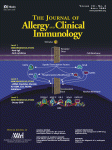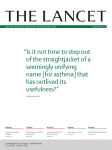Phase Three Time Trends
Until ISAAC Phase Three, only 5 centres in the world had previously conducted collaborative time trends studies in all 3 conditions using standardised methods. While a number of other centres had used standardised methods to study asthma trends over time, different centres had used different methods so the findings were not comparable between centres. Most centres who undertook ISAAC Phase One repeated the study after at least five years, reflecting the large worldwide interest in time trends of prevalence. For most centres it was the first opportunity to obtain time trends information. The time trends results in 2 age groups from 104 centres in 55 countries provided very helpful new information on the direction and magnitude of change in [Asher 2006]. In many regions with developing countries, an increase in the prevalence of symptoms was found more commonly than a decrease in the prevalence of symptoms for all 3 conditions. In centres where symptom prevalence had previously been low, it mostly increased, and where it had been high it mostly decreased or did not change. The rise in prevalence of symptoms in many centres in countries with high populations suggests that the world burden is increasing. Paradoxically at the same time the global disparities are decreasing.
Asthma time trends
Following reports from English language countries in the 1990s of increases in asthma prevalence from the 1980s, continuing increases in prevalence had been expected. However ISAAC found that in most high prevalence countries, particularly the English language countries, the prevalence of asthma symptoms changed little between Phase One and Phase Three, and even declined in some cases [Pearce 2007]. In contrast, a number of countries that had high or intermediate levels of symptom prevalence in Phase One showed significant increases in prevalence in Phase Three. Examples include Latin American countries such as Costa Rica, Panama, Mexico, Argentina and Chile, and Eastern European countries such as the Ukraine and Romania. Other countries with significant increases in symptom prevalence included Barbados, Tunisia, Morocco and Algeria. With the exception of India, all of the countries with very low symptom prevalence rates in Phase One reported increases in prevalence in Phase Three. The overall percentage of children and adolescents reported to have ever had asthma increased significantly, possibly reflecting greater awareness of this condition and/or changes in diagnostic practice. The increases in asthma symptom prevalence in locations of high population density such as Africa, Latin America and parts of Asia indicate that the global burden of asthma is continuing to rise, and at the same time the global prevalence differences are lessening.
Rhinitis time trends
Before ISAAC Phase Three there had been little study of changes in rhinitis or hayfever over time. In the 13- to 14-yr age group 106 centres in 56 countries and in the 6- to 7-yr age group 66 centres in 37 countries studied, a slight worldwide increase in rhinoconjunctivitis prevalence was observed, but the variations were large among the centres and there was no consistent regional pattern [Björkstén 2008] . Prevalence increases in the older children exceeding 1% per year were recorded in 13 centres, including 3 of 9 centres in Africa, 2 of 15 in Asia-Pacific, 1 of 8 in India, 3 of 15 in Latin America, 3 of 9 in Eastern Europe and 1 of 34 in Western and Northern Europe. Decreasing rhinoconjunctivititis prevalence of similar magnitude was only seen in four centres. The changes were less pronounced in the 6- to 7-yr-old children and only in one centre did any change exceed 1% per year. The decrease in highest prevalence rates in ISAAC Phase I suggests that the prevalence has peaked in those regions. An increase was recorded in several centres, mostly in low and mid-income countries. The increases were more pronounced in the older age group, suggesting that environmental influences on the development of allergy may not be limited to early childhood.rhinoconjunctivitis
Eczema time trends
At the time of ISAAC Phase Three it was unclear whether eczema prevalence was truly increasing worldwide. In 13 to 14 year old children from 105 centres from 55 countries and 6 to 7 year old children in 64 centers from 35 countries annual prevalence changes in relation to average prevalence across Phase One and Three were generally small and differed in direction according to the age of the participants and world region [Williams 2008]. For 13 to 14 year olds, eczema symptom prevalence decreased in some previously high prevalence centress from the developed world, such as the United Kingdom and New Zealand, whereas centers with previously high prevalence rates from developing countries continued to increase. In the children 6 to 7 years old, most centers showed an increase in current eczema symptoms. Similar patterns to these were present for severe eczema at both ages. Thus the epidemic of eczema seems to be leveling or decreasing in some countries with previously high prevalence rates. The picture elsewhere is mixed, with many formerly low-prevalence developing countries experiencing substantial increases, especially in the younger age group.




